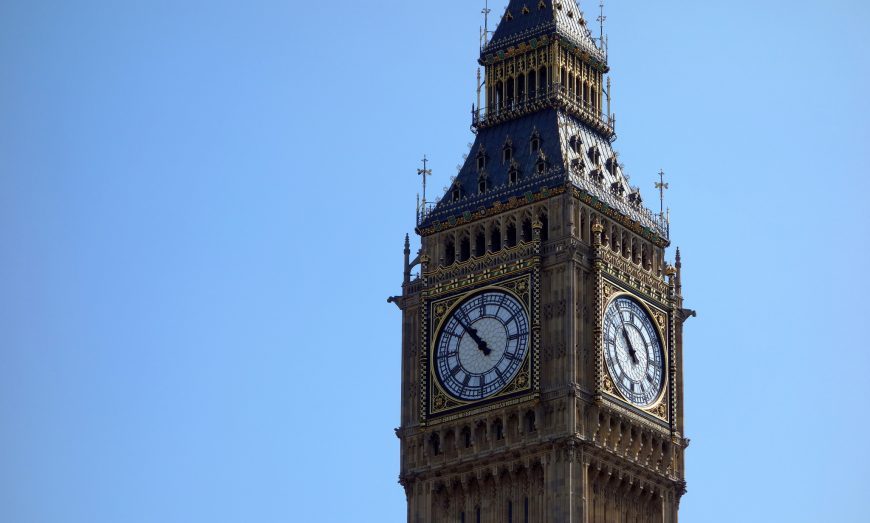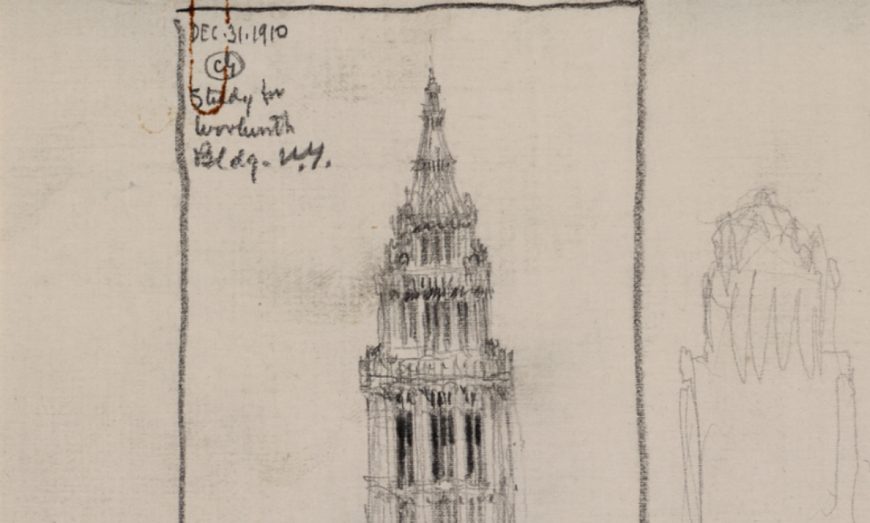This church contains traditional Gothic elements, but looks like nothing you’ve ever seen.
Antoni Gaudí, Church of the Sagrada Família or Basílica i Temple Expiatori de la Sagrada Família Basilica, 1882– (consecrated 2010, but still under construction), Barcelona, Spain. Speakers: Dr. Beth Harris and Dr. Steven Zucker
[0:00] [music]
Dr. Steven Zucker: [0:05] We’re in Barcelona, standing in front of Sagrada Família, the most unusual building I have ever seen.
Dr. Beth Harris: [0:11] The audio guide describes it as eclectic. I think that that’s a good description.
Dr. Zucker: [0:16] Most of the church is actually the result of work that’s taken place after Gaudí, but is fairly strictly adhering to his original program.
Dr. Harris: [0:24] We’re in front of one of three façades; this one’s called the “Passion Façade” and it’s decorated with sculptures representing Christ’s suffering and man’s sinfulness.
Dr. Zucker: [0:35] These are much later sculptures.
Dr. Harris: [0:36] Right now the sun is shining on it, but there are giant shadows cast by these columns that emerge from the façade and, in a way, serve to bring us in, they reach out to us.
Dr. Zucker: [0:49] I almost don’t want to call them columns because they’re at such a stark angle. Columns are not at angles like this. These are buttresses.
Dr. Harris: [0:55] Right, these are a little bit more like buttresses.
Dr. Zucker: [0:57] As you look at their bases, they look like the bottoms of the trunks of trees, something totally organic about them.
Dr. Harris: [1:04] In fact the façade feels sort of like a web, doesn’t it?
Dr. Zucker: [1:07] It does, and it feels as if those columns are actually being stretched, the way that a web might be stretched, and that there is something that’s actually mutable about them, that they’re moving.
Dr. Harris: [1:17] There’s a strange mixture of a sense of geometry and planarity and a sense of movement and the organic.
Dr. Zucker: [1:24] The church takes the position that that geometry is actually a way of expressing what is important in the Catholic tradition.
[1:32] In fact, Gaudí spoke of the notion of the grid, which he’s turning and curving in space, as actually being [a] set of three elements, of the vertical, of the horizontal, and of the intersection of the two, locking them in place. The vertical being God the Father, the horizontal being Christ, and the intersection being the Holy Spirit.
[2:00] Oh, you can hear the bells of the church now.
[2:02] There is a interesting attempt to fully integrate symbolism, church tradition, structure, and of course the aesthetics of the church itself into a perfect and unified whole.
Dr. Harris: [2:15] Like the Gothic architects, Gaudí wanted to create the heavenly Jerusalem and the feeling, when one entered the church, of entering heaven on Earth.
Dr. Zucker: [2:25] I think that’s a perfect segue. Let’s go inside.
Dr. Harris: [2:27] OK.
Dr. Zucker: [2:28] We’ve just walked into Sagrada Família and it is extraordinary. It is a kaleidoscope of light, and darkness, and form.
Dr. Harris: [2:37] Actually, I think the word kaleidoscope is a good one, because in a kaleidoscope, you move the ring around and the forms change. It feels very much like that. As you look up at the ceiling, there is geometric shapes, and fracturing of shapes, and color coming in from the stained glass windows, and a real complexity and mystery.
[3:00] I keep thinking about that forest metaphor, which is really true. It feels like one is walking into a stone forest.
Dr. Zucker: [3:07] We should mention that the church is quite loud, there’s a lot of background noise. There’s a lot of dust in the air, and that’s because there are literally dozens of workmen who are busily preparing for the pope’s visit later this week.
[3:19] This church has been under construction since 1882 and now, in 2010, the pope is coming to visit, this week, to consecrate the church. They’re going to make sure that the interior is ready for him.
Dr. Harris: [3:31] There’s amazing light coming in through the stained-glass windows, but also through the clear glass along the nave, and it really has that sense of the effect of dappled sunlight coming through a forest.
Dr. Zucker: [3:45] This is the strangest integration of classicism, but also of the Gothic notion of the organic, of the church as something that grows, in a sense, up to heaven, but here taken much more literally.
[3:59] If we look at the individual piers, which are one of the great units, of course, of traditional Gothic architecture, we have something, in some ways, much more complex. Not only is each pier — although paired with another — quite individual, but within the individual units, there’s a incredible geometric complexity.
[4:18] Starting at the bottom, we have a grounded lobing that eventually clarifies into a more traditional Doric fluting, which then divides — almost as if it’s alive — and the number of points in the flutes actually double, and then double again, until the column almost becomes simply a round.
Dr. Harris: [4:36] I find the capitals to be among the strangest things I’ve ever seen in my life. Some of them are decorated with oval shapes, but then others of them have this giant oval on one side of them, filled with glass and images that seem to be lit from inside the column.
[4:58] It’s creepy, and organic, and animal-like, and forest-like, and leaf-like, and simultaneously Gothic church-like, all at the same time.
Dr. Zucker: [5:10] The church is an enormously successful synthesis of bravery, of invention, of both classical and Gothic form, of geometry, of piety, and of linking our contemporary world and our contemporary technologies with an extraordinary historical precedent.
[5:30] [music]

View of construction in February 2014, Antoni Gaudí, Church of the Sagrada Família or Basílica i Temple Expiatori de la Sagrada Família, 1882– (consecrated 2010, but still under construction), Barcelona, Spain (photo: Karl432, CC BY-SA 3.0)
120 years and counting
Although Antoni Gaudí was influenced by John Ruskin’s analysis of the Gothic early in his career, he sought an authentic Catalan style at a time, the late 19th century, when this region (currently mostly in northern Spain) was experiencing a resurgence of cultural and political pride. Ruskin, an English critic, rejected ancient classical forms in favor of the Gothic’s expressive, even grotesesque qualities. This interest in the value of medieval architecture resulted in Gaudi being put in charge of the design of Sagrada Família (Sacred Family) shortly after construction had begun.
Gaudí was a deeply religious Catholic whose ecstatic and brilliantly complex fantasies of organic geometry are given concrete form throughout the church. Historians have identified numerous influences especially within the northeast façade, the only part of the church he directly supervised. The remainder of the church, including three of the southwest transept’s four spires, are based on his design but were completed after Gaudí’s death in 1926. These include African mud architecture, Gothic, Expressionist, of course a variant of Art Nouveau that emphasizes marine forms.

Nave ceiling, Antoni Gaudí, Church of the Sagrada Família or Basílica i Temple Expiatori de la Sagrada Família, 1882– (consecrated 2010, but still under construction), Barcelona, Spain (photo: SBA73, CC BY-SA 2.0)

View of the Passion Façade, Josep Maria Subirachs (sculptor), Antoni Gaudí, Church of the Sagrada Família or Basílica i Temple Expiatori de la Sagrada Família, 1882– (consecrated 2010, but still under construction), Barcelona, Spain (photo: Mstyslav Chernov, CC BY-SA 3.0)
The iconographic and structural programs of the church are complex but its plan is based on the traditional basilica cruciform found in nearly all medieval cathedrals. However, unlike many these churches, Sagrada Familia is not built on an east-west axis. Instead, the church follows the diagonal orientation that defines so much of Barcelona, placing the church on a southeast-northwest axis.
The Glory Façade (southeast):
This will eventually be church’s main façade and entrance. As with the transcept entrances, it holds a triple portal dedicated to charity, faith, and hope. The façade itself is dedicated to mankind in relation to the divine order.
The Passion Façade (southwest):
Dedicated to the Passion of Christ, its four existing belltowers are between 98 and 112 meters tall and are dedicated to the apostles James the Lesser, Bartholomew, Thomas and Philip (left to right). Josep Maria Subirachs is responsible for the façade sculpture.

Passion Façade (detail), Josep Maria Subirachs (sculptor), Antoni Gaudí, Church of the Sagrada Família or Basílica i Temple Expiatori de la Sagrada Família, 1882– (consecrated 2010, but still under construction), Barcelona, Spain (photo: Mstyslav Chernov, CC BY-SA 3.0)

View of the Nativity Façade, Antoni Gaudí, Church of the Sagrada Família or Basílica i Temple Expiatori de la Sagrada Família, 1882– (consecrated 2010, but still under construction), Barcelona, Spain (photo: Canaan, CC BY-SA 3.0)
The Nativity Façade (northeast):
Depicts the birth of Christ and is the only façade to be completed during Gaudi’s lifetime. its four existing belltowers are between 98 and 112 meters tall and are dedicated to the saints Barnabas, Jude, Simon and Matthew (left to right).
Ten additional belltowers (98–112 meters high) are planned though these will be overwhelmed by six towers that will be significantly taller. Four of these towers will be dedicated to the Evangelists, one to the Virgin Mary, and the grandest, rising to 170 meters, to Jesus Christ.

Nativity Façade (detail), Antoni Gaudí, Church of the Sagrada Família or Basílica i Temple Expiatori de la Sagrada Família, 1882– (consecrated 2010, but still under construction), Barcelona, Spain





